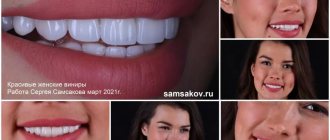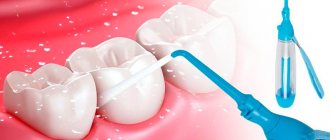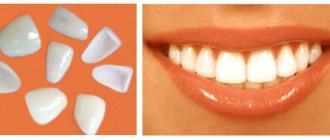To understand which veneers to choose, ceramic or composite, let’s take a closer look at what dental veneers are and what their features are. Veneers are thin plates of ceramic (sometimes zirconium) or composite material that are fixed to the front side of the teeth. Such microprostheses are used to correct aesthetic defects of the dentofacial apparatus and provide additional protection to the enamel. The onlays, made from impressions, imitate the natural shade of the dentition and do not stand out from it.
Veneering straightens the dentition, hides defects (uneven teeth, large interdental gaps, cracks or chips of the coronal shell), simplifies oral hygiene, and serves as an effective means of preventing periodontal diseases.
Author of the article: Meliksetyan Daniel Oganesovich
Work experience:
15 years
Specialization:
Dentist-orthopedist
Works:
at the clinic on Proletarskaya metro station
Differences between composite and ceramic veneers
Veneers made of composite material are otherwise called direct - due to the method of creation. The doctor plays the record in 1.5 - 2 hours while the patient is in the dental chair. In some cases, an impression is taken of the teeth and the veneers are cast from the impression in the laboratory.
Direct veneers are extremely firmly connected to the tooth tissue, this is facilitated by the layer-by-layer technology of applying a composite to damaged enamel. It is impossible to tear the created plate from the foundation. The tightness of the composite veneer is extremely high - there is not the slightest gap between the base and the coating that could provoke the growth of pathogenic flora. At the same time, the composite veneer retains its plasticity and does not cause discomfort. Preserving color and transparency for many years, the prosthesis maintains the impression of the naturalness of the restored tooth.
Ceramic veneers or zirconium veneers are made exclusively in a dental laboratory using high-precision impressions. They are attached to the patient's teeth using a specially developed adhesive. There are several known methods for making ceramic veneers: pressing under pressure, casting on a refractor, cutting from a molded blank. These thin plates in finished form also very reliably imitate the appearance of human enamel, so correcting the aesthetics of a smile with such overlays is always successful.
How to make a choice?
As you can see, composite and ceramic veneers differ significantly from each other, having a considerable number of features. When making a choice, it is important to take into account all factors at once, from the severity, volume and type of lesion to financial capabilities.
Highly qualified dentists at the Apex clinic will always advise you on the optimal method for restoring teeth in your particular case. Within the walls of our clinic, they will always meet you halfway and be able to offer truly effective smile correction methods that meet all your requirements and expectations!
Features of direct veneers
People choose this restoration method for a number of reasons:
- It's inexpensive and fast. Composite veneers are installed in one clinic visit; there is no need to plan long-term treatment or schedule trips to the dentist. The cost of the composite is much lower than the production of ceramics.
- The removal of enamel from the surface of the teeth is extremely minimal, sometimes only required in places.
- There is a clear similarity between composite veneers and the enamel of natural teeth.
- It is attracted by the high adhesion of the artificial material to living tissues.
The technique has some disadvantages:
- The quality of the final composition greatly depends on the experience and qualifications of the doctor. This drawback, however, is inherent in any result of a dentist’s work.
- Tarnishing of a record over the years. It can be eliminated by polishing the veneer once every six months.
- Changes in the color of the veneer due to frequent consumption of coloring foods and drinks. Cannot be corrected.
- Corrosion of a composite veneer under the influence of ethanol occurs with regular drinking of alcohol and when rinsing the mouth with alcohol-containing rinses.
What to choose
The main advantage of composite restorations over porcelain structures is their lower price and the ability to reduce the time spent on their installation. However, this advantage can no longer be called relevant today, since technologies have appeared that make it possible to install ceramic overlays in a day.
Reviews from doctors and patients indicate that veneering eliminates dental defects, but composites are less able to imitate the natural shade and structure of the enamel. The disadvantage of composite onlays is their inaccurate fit to the tooth surface, which causes the accumulation of bacterial plaque, increasing the risk of developing caries and periodontal inflammation.
The choice of veneering type depends on the number of restorations planned, the need for additional treatment and other factors.
Composite veneers are an excellent solution for the restoration of 1-2 teeth. But if there are problems in the entire frontal area, it is better to install orthopedic ceramic overlays.
Pros and cons of ceramic veneers
The advantages of silicon oxide overlays are obvious:
- Lack of ability to oxidize, change color, or degrade. Ceramic veneers do not absorb pigments from food and do not disintegrate under the influence of acids and alcohols. They will not show any stains or discoloration throughout their entire service life.
- Ceramic veneers will last for more than a decade if initially installed correctly and handled with care.
- The plate is very durable, despite its microscopic thickness, not reaching even a millimeter.
- Imitation of enamel is the best among other veneering techniques.
Flaws:
- The cost of ceramic veneers is not affordable for every patient.
- The impossibility of quick prosthetics sometimes becomes extremely difficult. A person will have to visit the clinic at least twice: to take impressions and for final installation. In addition, you will have to spend money on making a temporary structure, which will need to be worn until the permanent veneers are glued.
- When preparing teeth for veneers, the doctor may overheat the tooth pulp, which can lead to inflammation and acute toothache.
Porcelain veneers require grinding down of the teeth. Composite veneers do not have high strength and durability. There is a better alternative to all options: install veneers without grinding your teeth Luxneers
Life time
Ceramic veneers are more durable than composite veneers. This is determined by the characteristics of the material: ceramics are denser, stronger, and are not subject to staining or changing color or surface texture over time. With proper care, ceramics last for decades. The service life of the composite is limited to five years, which is determined by the properties of the material itself: under the influence of an aggressive environment and mechanical loads, its surface changes, wears out, and becomes porous, which is why the surface of the crown darkens or becomes stained and loses its gloss.
Reasons for installing veneers
If one or two teeth require restoration, it is more profitable to install composite veneers, but ceramics are not at all prohibited. If there are many cosmetic defects and you need to cover three or more teeth, it is advisable to use porcelain veneers.
General indications for veneering:
- Masking darkening of enamel, the presence of erosive areas, small chips and cracks, stains.
- Correction of hypersensitivity of teeth.
- Improving the appearance of the tooth after treatment of pulpitis or caries. Behind the veneer, like behind a shield, it is possible to hide fillings and tooth darkening as a result of nerve removal.
- Changing the shape of the tooth, giving the effect of uniformity in the row.
- Covering interdental spaces and wide crevices.
When choosing to improve the aesthetics of your smile with veneers, you will have to follow the instructions of your dentist. The doctor has the right to refuse to place veneers on the patient if the following diseases are traced in the anamnesis:
- Bruxism (uncontrollable night grinding of teeth);
- Deformation of gum tissue, periodontal disease, gingivitis, poor sanitary condition of the oral cavity;
- Too massive fillings on the teeth, exceeding the volume of remaining living tissue;
- Malocclusion;
- Allergy to components of the composite mass.
Do you still think that veneers without grinding of teeth Luxneers or composite are better?
Make an appointment
Or call +7(985)532-21-01
Nanoneers
Nanoneers
There is a misconception that nanoeers are a new generation of American lumineers. This is not entirely true.
This veneer design is created in Russian clinics, but from material and technology developed in Switzerland. The ceramics used to make nanoirs contain nanoparticles, which significantly improves the quality of the material.
The similarity with lumineers is that the abutment tooth is not ground down before installation. However, after the onlay is fixed, it must be polished and adjusted to the size of the tooth.
The advantage of this type of overlay is that they are cheaper than ultraneers and lumineers. But at the same time they are not so durable and aesthetically pleasing. In Russia, such prostheses are installed only in some clinics.
Is it always possible to get veneers?
Installation of veneers and lumineers is carried out only on healthy teeth. Therefore, before installing any type of onlays, the patient needs to visit the dentist’s office and undergo a full examination of the oral cavity - to cure caries and get rid of possible problems with the gums. This is necessary so that in the future, when installing veneers, no problems arise, and they do not have to be removed ahead of time.
It must be remembered that, like any medical procedure, the installation of veneers has contraindications:
- the presence of a pronounced malocclusion, which must first be corrected with braces or any other removable denture;
- bruxism - involuntary “grinding” of teeth, which can destroy even a durable denture;
- the absence of more than 50% of the tooth or the presence of a large filling on the surface of the tooth, which will make it difficult to securely fix the onlay on the tooth;
- lack of chewing teeth;
- pathological abrasion of teeth;
- periodontal disease.
As you can see, many contraindications are relative - they, one way or another, can be eliminated by the dentist, after which veneers can be installed.
To avoid any unpleasant moments in connection with the installation of veneers and to make your smile shine again and bring you joy, you need to contact only professionals.
Stages of restoration and restoration of teeth
- Preparation. Includes examination of the oral cavity and hygienic cleaning. It is necessary to determine the natural color of the patient’s teeth, and not the color of deposits, and to select the appropriate material to match it. In addition, there should be no dental deposits between the tissues and the restoration material so that they do not interfere with adhesion (adhesion to the surface).
- Tooth treatment. Old fillings are removed. Depulpation (nerve removal) and root canal filling are performed, if necessary. Grind the tooth to the required size. An impression for the microprosthesis is taken from it and sealed with a temporary filling or temporary veneer (only for the indirect method).
- Restoration. Photopolymers are applied layer by layer until the desired shade and transparency are achieved. They form the correct shape (for the direct method). Try on and install an inlay or veneer (for the indirect method).
- Finish polishing. A dental bur is used to remove excess restorative material so that it does not disturb the bite. The restored areas are sanded to give them a natural shine.
Dental restoration
When the dentition is destroyed, the enamel is damaged or irreparably changed color, the dentists at the GDenta clinic recommend aesthetic dental restoration.
This procedure allows you to completely restore the damaged area, return a beautiful and natural smile, and with it the ability to bite and chew solid food freely. Dental restoration is the general name for methods and technologies aimed at restoring the appearance and functions of the dentition. For each patient, the dentist draws up an individual treatment plan and selects the optimal method. Experienced GDenta doctors take into account the location of the damaged fragment: upper or lower dentition. The condition of the oral cavity and the presence of concomitant diseases in the patient are also important.
The price of dental restoration depends on the chosen method, materials and complexity of therapy. However, our dentistry offers affordable prices, because we are confident that patients should not delay therapy due to financial issues. That's why we also offer interest-free installments for services.











